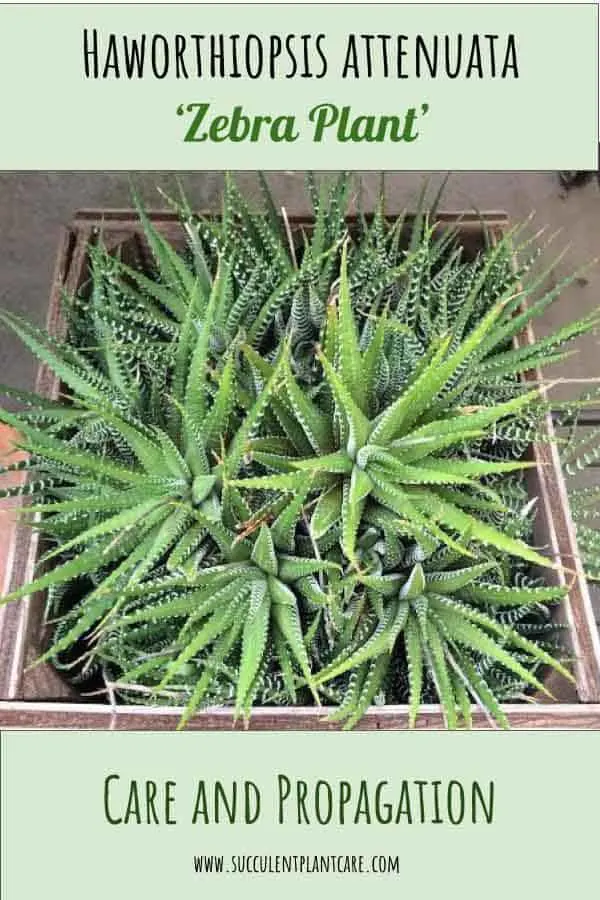Formerly known as Haworthia Attenuata, these plants are native to the Eastern Cape province of South Africa. They closely resemble an aloe plant; in fact, they are from the same subfamily. They have pointy leaves with zebra-like white stripes that appear as warty growth.
When touched, you can feel the little bumps or ridges from these white stripes. They can be grown indoors or outdoors and can tolerate different lighting conditions.
These are one of those succulent plants that would do well both indoors and out. They are slow growers at first, but can grow rapidly and produce pups and offsets once established.

Haworthiopsis Attenuata ‘Zebra Plant’ Varieties
There are several different types of Haworthiopsis Attenuata ‘Zebra Plant’. Perhaps the most popular of them is Haworthiopsis Attenuata Variegata ‘Variegated Zebra Plant.’ These have yellow and green leaves that appear horizontally on the foliage of the plant. The leaves are also covered with white warty spots all over. Care for these plants are similar and is described in details below.
Haworthiopsis Attenuata ‘Zebra Plant’ Care
Indoor Lighting Requirements
Haworthiopsis Attenuata ‘Zebra Plant’ can tolerate a wide range of lighting conditions which make them a very popular houseplant. They can survive poor lighting conditions for quite some time and are therefore ideal choices for indoor plants and terrarium containers. However, to keep them really happy, they need approximately 4-6 hours of bright, filtered light per day.
Place in a bright location indoors, anywhere where there is plenty of light. These plants can tolerate low light or poor lighting, but not for prolonged periods of time. If you have them in a dark area, you can move the plant to a brighter location from time to time supplement their lighting needs.
You may also consider using a grow light. Grow lights can help supplement your plants’ lighting requirements especially during those long, dark winters. Here are some of my grow light recommendations.
To read more about this topic on indoor lighting for succulents, check out my post on “Proper Lighting for Succulents Indoors” to get some helpful tips.
Outdoor Sunlight Requirements
Haworthiopsis Attenuata ‘Zebra Plant’ do best in areas that receive plenty of bright filtered light. They can tolerate low lighting conditions but bright indirect light is ideal. They can also tolerate full sun but needs to be slowly acclimated to prevent burning the plant.
If kept outdoors, place in a bright location away from intense sunlight or full sun. They do best with morning light which is less intense than afternoon sun. Before moving the plant outdoors or increasing the amount of sunlight it receives, it is better to acclimate the plant to help prevent sunburn or sun damage.
Slowly increase the amount of sunlight it receives until it is fully acclimated to the sun. Keep in mind that even when the plant is already acclimated to full sun, it can still get sunburned during a heatwave or intense heat. Sunshades are a real lifesaver for my plants during the intense summer heat here in Northern California where the temperatures can rise above 100℉ or 37.8℃. Here are some of my recommendations for sunshades and sun protection.
For further details and information on outdoor sunlight requirements, please visit my post “How Much Sunlight Do Succulents Need Outdoors?” to get some useful tidbits.
Haworthiopsis Attenuata ‘Zebra Plant’ are hardy in USDA hardiness zones 9-11.
Frost Tolerance
Haworthiopsis Attenuata ‘Zebra Plant’ can tolerate mild frost and freezing temperatures as long as they are not for long periods of time. If you live in USDA hardiness zones 9-11, you can leave the plant outdoors all year long and they can even be planted in ground. As I mentioned above, I keep mines outdoors all year long, and they survive the freezing rain and frost we experience in winter time.
If you have extreme winter conditions in your area, the best way to grow these plants are in containers. That way you can bring them indoors during winter or when there is forecast of frost or snow. In case you can’t bring them in, there are ways to protect the plants from frost and freezing temperatures outdoors. You can use frost cloths or mini greenhouses to help them survive the cold winter. Here are some of my recommendations for frost protection.
For further tips on this topic, check out my post on “Optimal Temperatures For Succulents to Survive and Thrive”.
Soil Requirements
Haworthiopsis Attenuata ‘Zebra Plant’ needs a well draining soil. The right type of soil goes hand in hand with proper watering. I have been using a simple, tried and tested concoction that has worked well for my plants.
I like to use a cactus potting mix combined with perlite for added drainage. I do not use exact measurements but eyeball it to about 2:1 solution of cactus mix and perlite. Others recommend using a sandy soil.
This can be achieved by mixing cactus mix or potting soil with coarse sand (about 2:1 ratio). I get most of my materials from a local hardware store. You can also purchase them online. Here are my soil recommendations. To read more about soil for succulents, click on “Best Soil and Fertilizer for Succulents” to get more useful information.
Watering Requirements
Watering largely depends on the climate you live in. Although these plants are highly adapted to dry weather conditions, they do much better when given sufficient amounts of water. There really isn’t a set schedule or formula on when to water succulents. My watering schedule is dictated by the very dry climate I am in.
In the summer months, I water my Haworthiopsis Attenuata ‘Zebra Plant’ as often as every 7-10 days, sometimes more during a heatwave. I cut back on watering to about every 10-14 days when the weather cools down. During the winter season, I mostly rely on rainwater and hold back on watering altogether because this is when we get a lot of rain in my area. But if we don’t get any rain at all during winter then I water at least once a month or every 2-3 weeks, depending on how dry the soil gets.
For those people in humid locations, you won’t need to water as much. And if you keep your plants indoors, you may not have to water as much especially if they are not receiving a lot of light. Too much water and not enough light is a recipe for disaster for these plants.
One good way to tell whether it’s time to water is to check the moisture of the soil. The top inch of the soil needs to feel dry before you can water again. If you are unsure how much and how often to water in the beginning, it’s always better to underwater and increase watering as needed. Pay attention to how your plant looks and you can adjust watering accordingly.
For further help with watering techniques, consider using tools like hygrometers or moisture meters to check for moisture in the soil and air. These tools are pretty affordable and can come in handy especially if you are unsure of when to water your plant next. I have narrowed down the choices here on my resource page. Do visit the page if you need help in gauging your watering needs.
Interested in finding out more about watering succulents? Visit my post “How And When To Water Succulents” where I go into more details about this topic.
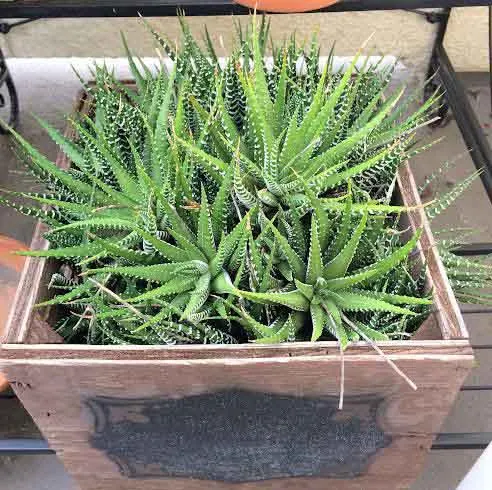
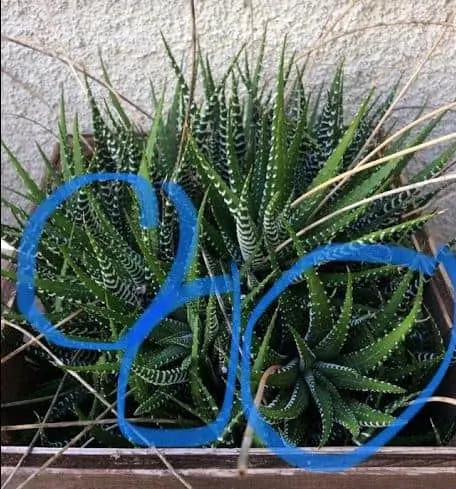
I circled it in blue to show how these pups can be separated from the mother plant. I am holding this project off until I get the time to do this. In the meantime, they are happily growing in this tight space.
Propagating Haworthiopsis Attenuata ‘Zebra Plant’
Haworthiopsis Attenuata ‘Zebra Plant’ produce pups and offsets or offshoots. The best ways to propagate these plants is by separating the pups or removing the offshoots from the mother plant. In my opinion, these methods are the easiest and quickest ways to propagate these plants.
Of course you’d have to wait until your plant produces pups or offshoots, which they readily do. I have read that they can also be propagated from leaf cuttings but this process will obviously take the longest. I have never propagated Haworthiopsis Attenuata from leaves but it looks like others have had success with this method. It will definitely require a lot more time and patience.
How to Remove Pups
Step 1: Find pups that appear large enough to be removed. Try to get some roots when removing the pup. You can remove a pup without roots, but you will have a much greater success with ones that have roots already growing.
Pups without roots will eventually root themselves, but the ones with existing roots have a greater chance of survival on their own. Likewise, bigger pups are stronger than smaller ones and will have a better chance at surviving on their own.
Step 2: Remove the pup. Some pups are easier to remove than others. Sometimes they can be separated by gently twisting the pup off the mother plant. It is better to remove the entire plant from the pot before separating the pup so you can see the roots.
Step 3: Use a clean knife. Other times you need to use a sharp tool such as a knife to remove the pup. Use a clean or sanitized knife and carefully separate the baby plant from its mother plant by inserting the knife blade between the mother plant and the offshoot. Slowly pull apart the pup from the mother plant and sever the connecting root.
If removing the pup while still planted in the soil, insert the knife blade into the soil between the mother plant and the offshoot. Slide the blade down the soil to sever the connecting roots. Carve out a 2-inch radius in the soil around the base of the offshoot then dig a few inches down the radial parameter using the sharp end of a small spade. Insert the spade at an angle underneath the offshoot and carefully pry it loose from the soil to remove.
Step 4: Let the pup dry for about a day or more to make sure any cut or open areas are dry and sealed or calloused. Keep in a dry location away from direct sunlight.
Step 5: Optional: Dip the pup in rooting hormone before planting. Rooting hormones can help speed this process up especially for pups without roots.
Step 6: Plant the pup. Once the pup is dry it can be planted on its own. Prepare a suitable well draining potting mix and plant the pup into the soil. Pack the soil lightly around the plant until secure.
Step 7: Water occasionally. Pups need a little more moisture than mature plants. Lightly mist the soil with a spray bottle every few days or when the soil feels dry. Once the plant is more established and rooted, stop misting and water more deeply. You can decrease watering to about once a week or less.
Step 8: Protect from direct sunlight. Protect new plants from direct sunlight when initially planted on its own pot to prevent sun damage. Gradually increase sunlight and sun exposure according to the plant’s needs as the plant matures.
How to Remove Offshoots
Aside from producing pups, Haworthiopsis Attenuata also shoots out offshoots or baby plants the same way they shoot out blooms. The offshoots will grow from what appears like a thin bloom stalk anywhere from the base of the plant. These can be removed by cutting them off.
It is better to wait until they are big enough before cutting them off to ensure survival. I have a few offshoots that I have removed from the mother plant and they are growing nicely on their own. (One is already producing its own pup–they grow up so fast sniff sniff, see picture below).
Step 1: Simply cut the offshoots off. You can use scissors. Let the offshoot dry for a day or so just to make sure there is no open wounds and the plant has calloused over. Keep away from direct sunlight.
Step 2: Once dry, plant in a suitable well draining potting mix.
Step 3: Optional: Dip the offshoots in rooting hormone before planting. Dipping in rooting hormone can help speed up the process, especially if the offshoots have not produced roots.
Step 4: Water occasionally. Pups need a little more moisture than mature plants. Lightly mist the soil with a spray bottle every few days or when the soil feels dry. Once the plant is more established and rooted, stop misting and water more deeply. You can decrease watering to about once a week or less.
Step 5: Protect from direct sunlight. Protect new plants from direct sunlight when initially planted in its own pot to prevent sun damage. Gradually increase sunlight and sun exposure as the plant matures.
Propagating From Leaves
(I have not tried propagating these plants by leaf cuttings but here’s what I found others do).
Step 1: Gently pull a leaf out, make sure you get the entire leaf including the base. You can just gently twist the leaf off the plant and it should come off easily. Try to find a nice plump leaf that looks healthy. It also helps to have more than one leaf just because not all of them will make it all the way to the end.
Step 2: Optional: Dip the cut ends in rooting hormone. Rooting hormone can help speed the propagation process up, especially when growing from leaves.
Step 3: Wait for the leaves to dry for about a day or two. Keep in a dry location away from direct sunlight.
Step 4: Prepare a well draining potting mix. Once dry, lay the leaves flat on the soil or stick the cut ends in soil.
Step 5: The leaves should start shooting out roots in about 2 weeks or so. In a few more weeks you will notice a new baby plant emerging. The whole process can take anywhere from a few weeks to months.
These are three different ways you can propagate a Haworthiopsis Attenuata ‘Zebra Plant’.
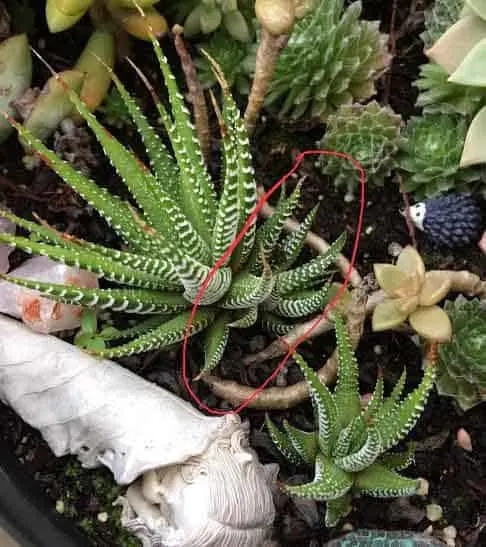
These are grown from offshoots of the mother plant. As you can see, it produced a small pup on the side. I circled it in red to show it better.
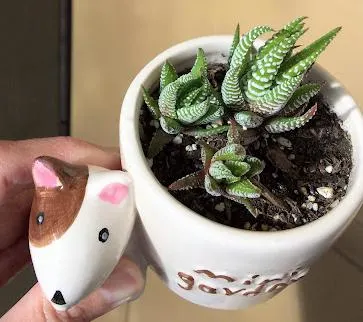
These are also grown from offshoots of the same mother plant. They were too small to be ideally potted on their own but they were getting sunburned where they were growing so I had to move them in their own pot. They are doing much better these days and have recovered from the sunburn.
Common Problems with Haworthiopsis Attenuata
Zebra Plant Leaves Turning Brown
The most common cause of brown leaves is sunburn. These plants do best under bright but filtered light. Simply move the plant to a shadier location to prevent sunburn. Sunburn spots on leaves are permanent but does not really hurt the plant internally, as long as the problem is corrected.
Zebra Plant Leaves Have Dried Tips
The most common reason for dried tips is underwatering. The tips of the leaves will appear brown and dried up. When this happens, it is a sign that the plant is running low on its water storage and it is time to water. Just give the plant a good drink of water and it should perk up within a day or so.
Zebra Plant Have Mushy Brown Leaves
The most common reason for mushy brown leaves is overwatering. The plant will look unwell and the leaves will get soft and mushy and appear translucent. These are telltale signs that you are overwatering your plant.
Cut back on watering and allow the plant to dry out and recover from too much water. Do not water until the plant has had a chance to dry out completely. If the soil is not drying out fast enough, consider switching to a fast draining one.
Root rot can develop when left in wet soil. Once you notice rot, you can still save the plant by cutting off the dead parts of the plant. Save anything that looks green and viable to propagate and repot.
Remember, it is easier to ‘fix’ an underwatered plant than an overwatered one so when in doubt, err on the side of caution when watering especially if you are not familiar with the plant.
Haworthiopsis Attenuata Blooms / Flowers
These plants readily bloom in the spring and summer months. They produce bell-shaped pale lavender flowers. Keep in mind that not all plants are ready to flower, and some may not bloom at all.
A lot of it depends on environmental factors beyond our control. To encourage blooms, make sure they are receiving adequate lighting. Along with proper lighting, make sure the plant is kept happy and receiving the proper care as mentioned above.
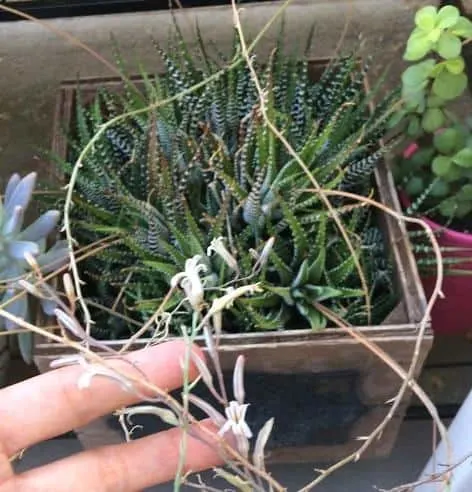
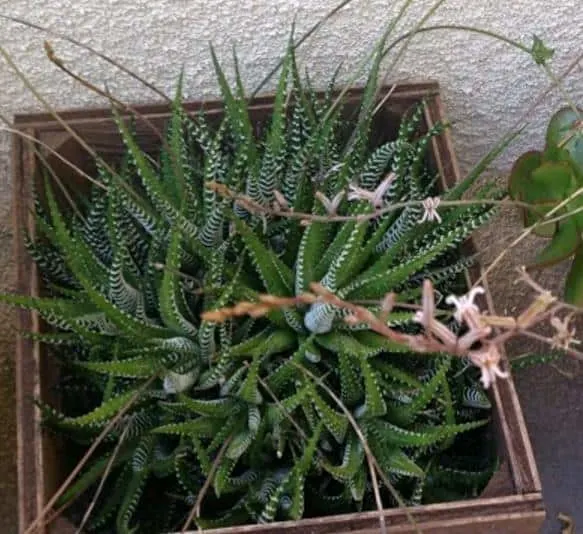
While fertilizing is not necessary, giving your plants the nutrients they need will help ensure proper growth and encourage blooms. It takes a lot of energy for plants to produce flowers, and feeding them extra nutrients will help supplement their needs during flowering season. The best time to fertilize is during the active growing season, or during spring and summer months. A balanced blend of fertilizer for houseplants or a fertilizer specially formulated for cacti and succulents are suitable. Fertilizers are better applied at a quarter or half strength, about every two weeks. Here are some fertilizers I recommend.
Along with the right environmental conditions, they also need to go through a wintering period to encourage blooms. This can be achieved by keeping them cool and dry in the winter months, with temperatures just above freezing between 35-44⁰F (1.5-7⁰C).
Toxicity to Cats, Dogs or Pets
Haworthiopsis Attenuatas are not toxic to cats or dogs according to the ASPCA website. If you suspect poisoning, contact your local veterinarian immediately or the ASPCA Animal Poison Control Center at 888-426-4435.
Haworthiopsis Attenuata ‘Zebra Plant’ is one of the most versatile succulent plants out there. They can be grown indoors and outdoors and will tolerate a wide range of lighting conditions. These plants are also very easy to care for and are great starter plants.
Where can you find Haworthiopsis Attenuata ‘Zebra Plant’? Check out my resource page for recommendations on where to purchase these and other succulent plants online.
Pin this post to save for yourself or to share with others!
